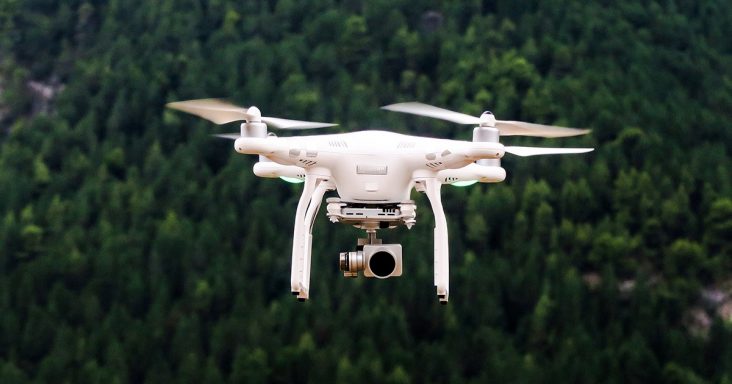Intel sees big opportunities with drone technology
by October 25, 2018 2:53 pm 619 views

Drones have been pegged as a better way to deliver final mile packaging and 7-Eleven convenience stores in select cities have been delivering hot coffee via drones for over a year. But Intel, a chip maker for electronics and computers, sees an entirely different business case for the high-flying machines, which are not yet autonomous.
Rachel Padgett, drone marketing strategy lead at Intel, said the rest of the world has seemed intrigued in why a chip maker was investing heavily into drone technology over the past few years. She said people ask her all the time if Intel just wants to ensure its chip technology is embedded into drones.
Intel’s technology does typically go into other products from laptop computers to large mainframes and even smartphones. Padgett said what is often missed is how rich drones are in sourcing data. She said Intel sees data as the next “oil” a currency that can transform the entire world.
Padgett was one of the speakers who presented earlier this week at the Northwest Arkansas Technology Summit in Rogers. She told the group her formal education was industrial engineering, but now she leads a team of innovators at Intel who focus on finding business and entertainment applications for drones.
“These UAV devices can collect accurate data in real time,” she said. “We see them being used in construction and we certainly use them our own building projects. The utility sector can also use drones to inspect lines and infrastructure that is hard for humans to do safely. Insurance companies are now using drones to inspect natural disasters to look for survivors or survey damages. The oil and gas industry is using drones to inspect wells and rigs off-shore at high elevations.”
The images a drone can capture are a very high resolution, and can get close enough to detect insects on the Great Wall of China, Padgett said. Intel is working in China to photograph the landmark at its highest elevations, which are very dangerous for humans to navigate. Not only were drones used to capture detailed images of the wall, but Intel also helped create a 3D model from all the accurate images captured by the drone from every angle. The insights have helped the China Cultural Foundation that is trying to preserve the structure to budget and better plan out the workflow for this massive project.
Intel is also using drones to help preserve historic churches, cathedrals and other legacy structures around the world. She said Intel sees this as an opportunity to test drone technology while also helping preserve history. There were 583 preservation projects funded in Germany in 2017 and Intel was able to help the government and historical agencies with projects such as a 15th Century cathedral in Normandy. The complete case study for the project can be found online.
Padgett said drones were flown close to the very steep roof and photographed the entire roofline so a plan could be made for restoration.
“This is important because it is very dangerous to send crews up there to do inspections, the crews will have to do repairs but they have an accurate model to follow and can get a better feel for the cost of the restoration. In this project, the drone actually found a patch of roof that told historians the building was quite older than they thought,” she said. “Indoor drones were also used to photograph the vast ceilings in need of repair.”
Padgett said with 9.1% of the bridges in the United States being structurally deficient, drones can be a better way of performing inspections. She said Intel drones are being used in that capacity.
In building out other use cases for drone technology, Padgett said agriculture is also getting a lift from insights gathered by drones. For example, scanning for irrigation breaks and counting plant crops for yield prediction is easier and more efficient than traditional, manual methods.
Intel is also interested in developing conservation projects that track animals in Africa or polar bears in the Arctic. Drones are also being used to help in plant pollination as bees — nature’s pollinators — are dying off across the Western Hemisphere. Even Walmart has filed a patent for a tiny drone that can pollinate crops.
David Wilkie, director of conservation for the Wildlife Conservation Society, has said drones are helping map changes in the status of ecosystems and wildlife habitat and can help locate illegal activities within parks, community reserves and conservancies.
Padgett said Intel has also invested in an entertainment vertical for its fleet of drones it uses in light shows. She said that use provides opportunities for art, entertainment and advertising. Intel drones were used in a light show at the Super Bowl halftime show two years ago. She said 1,200 drones were flown and operated by one person in that show. The drones built for light shows and entertainment are lightweight at only 330 grams and capable of 4 billion LED color combinations.
Padgett said for Intel’s 50th anniversary this year. One pilot flew a world record 2,018 drones in a light show at Folsom, Calif., and the light artistry was choreographed to music.
“These events are incredible to see. We also used 1,200 drones to create the Olympic rings in the opening ceremony in Korea two years ago,” Padgett said. “We think drone light shows could be the next form of entertainment, taking place of firework shows. These drones can create 3D animations and they look like a giant Lite Brite (toy) in the sky.”
Padgett said Intel has pushed way beyond its core business and has embraced drone technology and artificial intelligence to try and impact the world for better and also drive more revenue to the bottom line.
